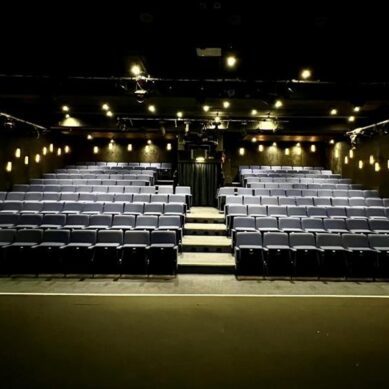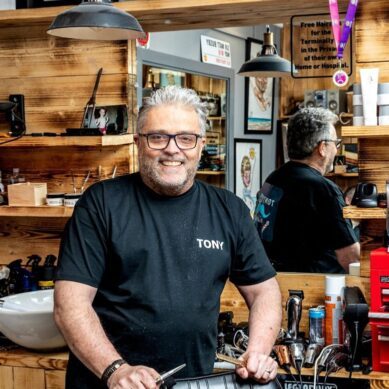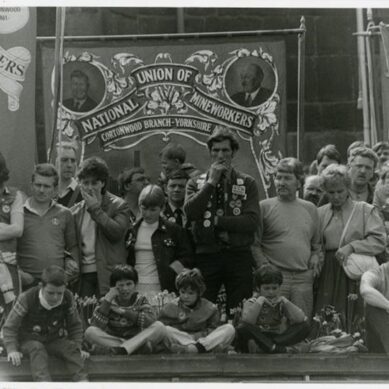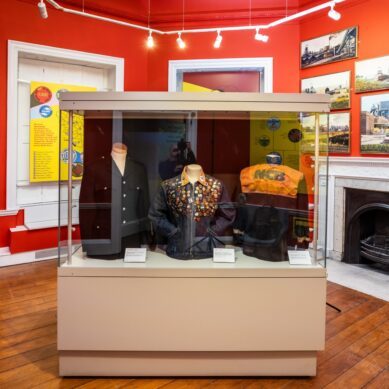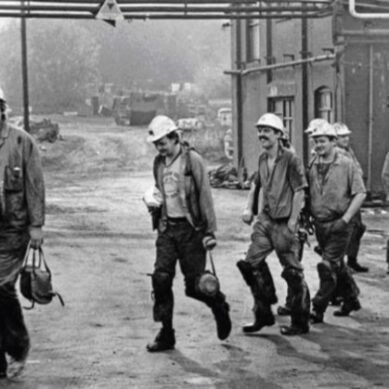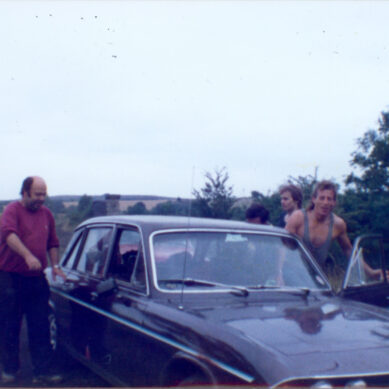Heritage is more than just historic grand houses and stately homes. History enriches every aspect of the community, from the remnants of industry to landmarks pitted into green landscapes that frame the society we know today. Stories and memories of days gone by continue to build a picture of the past for the generations of the future.
And now, thanks to funding from Historic England, a new project run by Rotherham Museums, Arts and Heritage unlocks the door to three historically important, yet often overlooked, sites at the heart of Rotherham communities, giving the key to fascination back to residents.
Collaborative Connections is a heritage project designed to increase awareness, accessibility and appreciation of Keppel’s Column, Catcliffe Glass Cone and Waterloo Kiln. Its focus is to reconnect the community with the heritage of these three sites and encourage residents to be involved in their future development, management and care.
As part of the project, three new community groups have been established and their main task has been to work with artists to create an exciting and innovative engagement programme to appeal to all sections of the community.
Here we look further into the history of these three sites, now owned by Rotherham Council.
Catcliffe Cone
The Beatson Clarke name has become synonymous with glassmaking in Rotherham. But some ten years before its inception in 1751, Catcliffe Glassworks was established by William Fenney, who built the intriguing glass cone that is perched on a small hill overlooking the road connecting Brinsworth and Catcliffe.

The building of Catcliffe Cone and the glassworks was said to be instigated by family dramas. William Fenney was previously the manager of Bolsterstone Glass Works in Stocksbridge, owed by his wife’s family. But a falling out with his mother-in-law led to him leaving to start his own company. She gave strict orders any new works were to be more than ten miles away from hers – Catcliffe is 10.5 miles away.
Catcliffe Cone is the oldest surviving of its type in Western Europe and one of only six that remain in the UK. But Fenney originally built two conical brick structures at Catcliffe, each reaching 66ft (20 metres) tall with archways around the base to allow for air entry. A previous calculation has indicated it must have required somewhere in the region of 120,000 bricks per cone. Inside was a large circular furnace with a flue that carried waste gas out through the top of the cone. Around the furnace was a circular platform that workers stood on.
The development of the use of these types of cones revolutionised the manufacture of glass, helping turn Britain into one of the leading centres of glass production in the world. In the 18th century, Catcliffe was one of ten sites of glass furnaces throughout South Yorkshire. It made bottles and window glass; in 1755 they supplied the Wentworth estate with 900 square metres of windows.
The Catcliffe glassworks changed hands many times over the next 130 years until it closed in 1887, reopening for a short time in 1900. After that, it was used as a Prisoner of War Camp during WWI and then a canteen during the Great Strike of 1926.

By the time Rotherham Council bought the building in the 1960s, it was derelict and in a poor state and threatened with demolition. Alan Austin grew up in the village at that time and remembers the area well.
“It was clearly visible to see where the furnace stood in the middle and one of the flues at the front was visible and blocked with broken glass. The floor of the cone was uneven and covered with clear glass mostly from kids playing in there and breaking bottles. Outside of the cone there were mounds of uneven ground and long grass. It was often possible to stumble across lumps of clear green glass that would have been used in the furnace.
“The locals always called it Skittle Alley, and as far as I am aware it had never been documented why it was so called. My theory is that Skittle is the name for a certain type of bottle and Alley is a passageway behind buildings. Could this have been an area where bottles from the Glass Cone were stored?
“A dust track ran alongside the cone and the local coal merchant, Mr Downsby, had a large garage where he kept his coal waggon. Topside of the tracks was an area called the Bankings which used to hold the traveling fairground that attended quite regularly. But it has also been mentioned that Joey Hodson used to bring his traveling circus and held shows in the cone,” Alan says.

As part of the Collaborative Connections project, the cone was lit up outside with an immersive light projection devised by visual art duo, Illuminos. The commission, called Cocoon, is based around metamorphosis and transformation, connecting this to local people through key moments of change and transformation in their lives. The dramatic visuals depicted how glassmaking has changed over time.
Keppel’s Column
Towering 115ft above Scholes village on the second highest hill in Rotherham, Keppel’s Column is the tallest of several follies in and around the Wentworth Estate. The 2nd Marquess of Rockingham, Charles Watson-Wentworth, who owned Wentworth Woodhouse and the estate from the mid-1700s, originally commissioned the column as part of a pyramid of follies which stood as way-markers to indicate the sheer size of his vast estate.

It was built between 1773-1780 by John Carr, the famous Georgian architect responsible for the Stable Block at Wentworth Woodhouse and nearby follies such as Needle’s Eye. However, following the acquittal of the Marquess’ comrade and fellow Whig, Admiral Augustus Keppel from a court martial case in 1777, the original design was to be redeveloped as a monument to the Royal Navy officer. Such an overly elaborate and ostentatious show of friendship, but this is the same Marquess who had George Stubbs paint over 20 of his horses, including his prized Whistlejacket.
No expense was usually ever spared, but for some reason the funding fell short with Keppel’s Column. Carr’s new design should have had a 30ft statue of Keppel on the top and carved ships at its base. But the column wasn’t completed as designed and what was eventually unveiled in 1780 was an oddly proportioned tower, its notorious bulge the result of an incorrect entasis.
Over the years, this design flaw has become a local talking point and the 35m column can be seen from many viewpoints across the town.

Before the 1960s, it was open to the public who could climb the 220 steps to the top if they dared. One such person who did was Nigel Simpson.
“I remember visiting Keppel’s Column on a school trip. The door had to be unlocked by a big old key that looked like something from Harry Potter. The thick door, reminiscent of a manor house or walled garden, didn’t lead to a secret garden but to solid stone steps leading in a spiral as far as one could see. As we embarked on this seemingly endless journey upwards there were times to catch your breath by an open slit that reminded me of an Archers window of older times. The thick and strong but hugging walls meant you could feel the air around you beginning to cool and apart from subdued, almost whispered chatter behind there was no sound from outside – not eerie but somehow peaceful and calming.
“As we neared the top, the quick glances at the widening view reminded us how high we were going. But emerging on to the platform was almost submarine-like thanks to the awe-inspiring unrestricted view, different to any wide angle or panorama lens of today’s drone cameras. We could feel the breeze and detect a faint aroma of the meadows and farm crops way below. No one wanted to look down. I remember the personal, almost insular, view of the clear but very distant horizon as if there was no one there except me.”
Jenny Lawless’ parents also dared to climb to the top of the column.
“Both my mum and dad, Rita and Colin Hewitt, now in their 80s, remember paying a penny as children and going up the Column during the 1940s and 50s. My dad says the halfway point was a good place to rest on the climb up via the many spiralling steps. But the view from the top was worth the climb – and the penny.”
The building fell into a hazardous state and was closed to the public and placed on Historic England’s at-risk register due to its critical condition. The council was given a grant from HE towards carrying out essential repair works but plans are now underway to restore this triumphal tower to its former glory. Along with replacing missing steps and strengthening the structure of the column, the plans will hopefully enable the viewing platform to be accessible again for future visitors to relive Nigel’s exhilarating experience at the top.

As part of the Collaborative Connections project, the focus group commissioned a light projection display by Matthew Rosier which reimagined Keppel’s Column as a giant grand entrance to Wentworth Woodhouse. Playing on the architectural style and scale of the monument, the display embraced the spirit of a folly – to surprise and delight – with Matthew filming local people appearing to walk past the column, the imagery of which was projected onto it.
Waterloo Kiln
Hidden away in Wath Wood sits the unassuming Waterloo Kiln, a moss-covered bottle shaped structure that many people would just pass by. But not only is this believed to be the only surviving 19th century pottery kiln in Yorkshire, it is also a residual reminder of the internationally renowned Rockingham Pottery which put Swinton on the global map.

There has been a pottery works on the site since 1745 when land was rented from Thomas Watson-Wentworth, 1st Marquess of Rockingham. It changed ownership various times over the next 50 years but production came to standstill by 1801. Part-owner at the time, John Brameld, appealed to the 4th Earl Fitzwilliam for help who provided a £2,000 loan to enable Brameld to buy the business outright from Leeds Pottery.
Under the Brameld era, the site was enlarged to increase production of the popular thick ‘Brown China’ earthenware with a high-shine lead glaze. The Waterloo Kiln was built in 1815 – the same year as the Battle of Waterloo, thus leading to its name – and was to be used to firing and glazing. However, while Brameld was a fine potter, his business acumen left a lot to be desired. The site was heavily supported by the Fitzwilliams throughout the early 19th century.
By the 1820s, the Bramelds had started experimenting with fine porcelain which elevated their profile but put even greater financial strain on the business. By 1826, they were on the brink of bankruptcy. However, seeing the potential of this new-era of production, the Earl bailed out the business once more, leading to its rebrand under the Rockingham Pottery name in his honour.
Most people in Rotherham will have seen or heard of the finest piece synonymous with Rockingham Pottery – the Rhinoceros Vase. Standing over 3ft tall, this elaborately designed vase is the largest piece of pottery fired in one piece and the Bramelds made two; one which is now in Clifton Park Museum and the other at the V&A Museum in London.

Their style was heavily decorated, somewhat gaudy, and garnered the attention of high society across the world. Indeed, many guests staying with the Earl at Wentworth Woodhouse would visit the pottery works to see the beautifully glossy milk-white porcelain in production.
They gained the Royal seal of approval when King William IV ordered a full dessert service that took eight years to make. But this would become the icing on the cake for their demise; the set was never paid for and led to bankruptcy. The third Earl Fitzwilliam seized all assets to clear their debts in the 1840s. A door and windows were added to Waterloo Kiln which became a house before it was used as an isolation hospital for smallpox patients.

At the Waterloo Kiln and Pottery Ponds at Swinton, artist Carlos Cortes has developed an art installation within the kiln, working with local schools and communities to create new life-size interpretations of the famous Rhinoceros Vase. There will also be a special trail of golden rhinoceros for children and families around the site.
